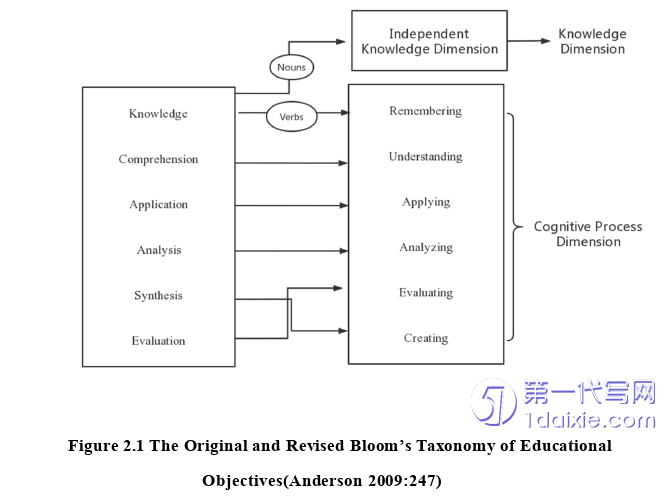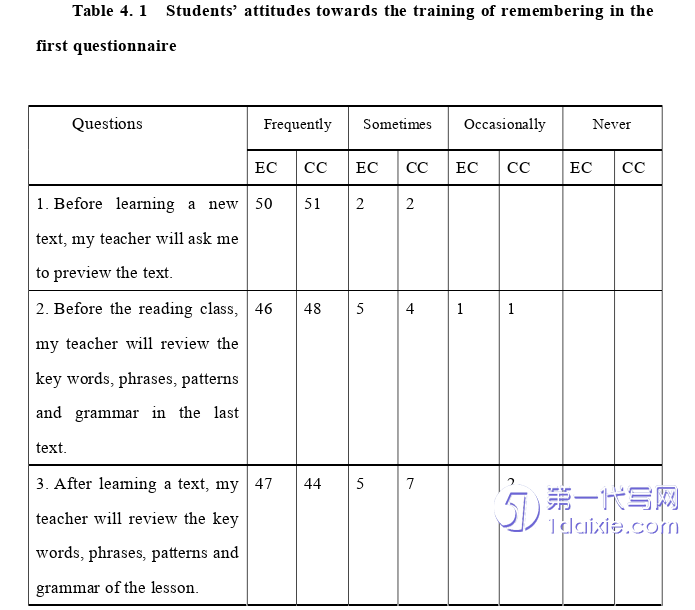本文是一篇英语论文,笔者认为在布鲁姆认知学习目标分类法的指导下进行英语阅读教学,可以改善学生的阅读习惯和策略,提高他们的阅读水平。然而,也有一些局限性。首先,本实验的样本范围相对较小。只有来自一所学校一年级两个班的105名学生和6名教师被选为研究对象。此外,由于为期4个月的实验时间有限,学生在实验后的测试成绩提高并没有达到预期。
Chapter One Introduction
1.1 Background
Reading is considered as one of the main ways for most Chinese students to learn a foreign language. It can enable students to acquire new subject knowledge, enhance emotional experience and cultivate thinking ability. Through reading, students can obtain information, acquire advanced technology, develop cross-cultural awareness and correctly understand the development of China and the world.
With the advancement of the new curriculum reform and the promulgation of the High School English Curriculum Standards (2017 edition, revised in 2020), senior high school teachers are paying more and more attention to students’ English reading learning. Reading allows students to experience a wider variety of textual styles, make them develop good reading habits gradually. Through reading, students can not only learn languages but also humanities and scientific knowledge, so as to expand their mind and improve their ability of aesthetics, appreciation and evaluation (The Ministry of Education: 27).
However, there are many problems and difficulties in senior high school classroom English reading teaching. While teaching English reading, teachers tend to let students memorize more words and language knowledge points, or focus on superficial understanding. Students deal with exercises mostly through simple checking for comprehension, and their application of language knowledge and skills only stays at a very low level. Teachers lack profound exploration and thinking of reading materials and rarely guide students to analyze and evaluate the materials in depth, let alone to process and create what they have learned purposefully. In this way, the quality of students' thinking can not be well developed, and the core quality of English subject can not be comprehensively improved.
1.2 Purpose of This Research
The author takes Bloom's taxonomy of cognitive learning objectives as the guide to conduct English reading teaching in a senior high school in Xingyi City, Guizhou Province. It is expected to solve practical problems to improve classroom English reading teaching and learning. More specifically, the three problems are to be explored as follows.
1.What is the current status of the application of English reading teaching guided by Bloom's taxonomy of cognitive learning objectives?
2. What are the effects of English reading teaching guided by Bloom's taxonomy of cognitive learning objectives on students' reading habits and strategies?
3. What are the effects of English reading teaching guided by Bloom's taxonomy of cognitive learning objectives on students' reading proficiency?
Chapter Two Literature Review
2.1 Bloom's Taxonomy of Cognitive Learning Objectives
Benjamin Bloom, a contemporary American psychologist and educator, divides teaching objectives into three areas: cognitive, affective, and psychomotor skills (Bloom, 1956). In 1956, Bloom published the Taxonomy of Educational Objectives, Handbook of Educational Objectives Classification: Cognitive Field, as a framework for the classification of educational objectives. In the 40 years since its publication, the book has been translated into more than 20 languages (Krath-Wohl, 1994), providing the basis for test design and curriculum development not only in the United States but also around the world. In a survey of the important books that influenced the school curriculum in the first 75 years of the 20th century. Shane H. G. (1981) found that the book was one of four books that scored from eighth to eleventh.

This research deals only with the educational objectives of its cognitive domain. The original Bloom's taxonomy of cognitive learning objectives consists of six main categories, which are arranged in the following order: knowledge, comprehension, application, analysis, synthesis and evaluation (Bloom, 1956). During the 1990s, Lorin Anderson, led a new assembly which met for the purpose of updating the taxonomy, hoping to add relevance for 21st century students and teachers (Forehand M. 2010). The new term are defined as remembering, understanding, applying, analyzing, evaluating, creating(Anderson & Krathwohl, 2001:67-68).
2.2 Higher- order Thinking Skills
In Bloom’s taxonomy of cognitive learning objectives, the first three levels, remembering, understanding and applying, are lower-order thinking skills, and the latter three, analyzing, evaluating and creating, are higher-order thinking skills.
Higher-order thinking skills cannot start until student master“fundamental facts” and conventional wisdom (Booker, 2008). Zhao Fang (2019) mentions that the first three items of remembering, understanding and applying belong to lower-order thinking, while the last three items of analyzing, evaluating and creating belong to higher-order thinking. Higher-order thinking skills are often developed in complex situations, such as problem analysis and critical thinking activities. They need to be trained.
Higher-order thinking is kind of mental activities or cognitive abilities that occur at a higher level of cognition. Lewis and Smith (1993) define higher-order thinking skills as an event when a person gets new information, saves it in their memory, and interconnects the information to find possible options in complicated situations. Nourdad and his fellows (2018) think that language teachers should aim at increasing the level of thinking in their classes. This can best be achieved through explicit instruction of higher-order thinking skills. Language teachers should raise higher level questions in their classes to invite the participants to think in higher levels. The tasks provided for the learners should make them analyze, evaluate and create new pieces of knowledge based on the acquired, comprehended and synthesized knowledge. Christian Bernard Nichols Djami (2020) holds that in order to use higher-order thinking skills, teachers should engage students in activities beyond comprehension. The activities should promote analysis, synthesis, and evaluation. At the same time, the performance of low-level thinking skills in language understanding and application plays a significant role in the overall learning level, which also directly affects the development of students' higher-order thinking skills (Zhao Yi, 2022). Therefore, we should pay attention to the cultivation of higher-order thinking skills while not ignoring the cultivation of lower-order thinking ability.
Chapter Three Research Design .................................... 23
3.1 Research Questions ...................................... 23
3.2 Participants ....................................... 23
3.3 Methodology ...................... 25
Chapter Four Results and Discussion ......................... 32
4.1 Results and Discussion of the Questionnaires .............................. 32
4.1.1 Remembering .................................... 32
4.1.2 Understanding ................................... 35
Chapter Five Conclusions .......................... 63
5.1 Major Findings .................................... 63
5.2 Limitations .................................... 64
Chapter Four Results and Discussion
4.1 Results and Discussion of the Questionnaires
There are 18 questions in the questionnaire, which can be divided into six categories. Based on the perspective of students, they investigated students' reading habits and strategies, and the status quo of application of Bloom's taxonomy of cognitive learning objectives in the classroom.
4.1.1 Remembering
The first part of the questionnaire is a survey on students’ reading habits and whether teachers pay attention to the remembering dimension of Bloom's taxonomy of cognitive learning objectives in reading teaching in students' minds. It contains 4 questions. The results of the two surveys are compared as follows.

Chapter Five Conclusions
5.1 Major Findings
After four months of experiments, the research results strongly prove that the senior high school English reading teaching guided by Bloom's taxonomy of cognitive learning objectives has a positive impact on Class 1, Senior 1 of a high school in Xingyi City, Guizhou Province. This chapter summarizes the three research questions raised in this thesis as follows.
First of all, Bloom's taxonomy of cognitive learning objectives have been involved in the teaching of English reading in senior high schools, but generally they are mainly focused on the training of lower-order thinking, while higher-order thinking has not been fully trained. It can be seen that Bloom's taxonomy of cognitive learning objectives is not widely used in English reading teaching in this high school.
Secondly, English reading teaching based on Bloom's taxonomy of cognitive learning objectives and focusing on educational objectives at all levels has a positive impact on students' reading habits and reading strategies. Combined with the regular training of low-order thinking skills and frequent training of higher-order thinking skills, students tend to be more interested in English reading and flexibly use different reading strategies to solve problems at different levels. It is worth noting that although the control class conducted the reading class according to the conventional group teaching planning of the whole grade, that is, the teaching method without deliberately carrying out the training of higher-order thinking skills, the reading interest and reading strategy of students were also improved, but not as obvious as that of the experimental class.
reference(omitted)
